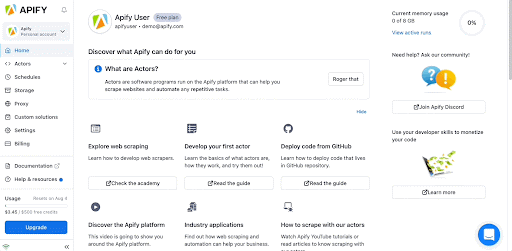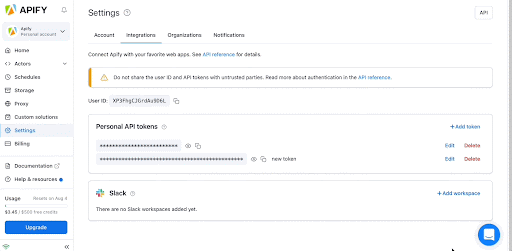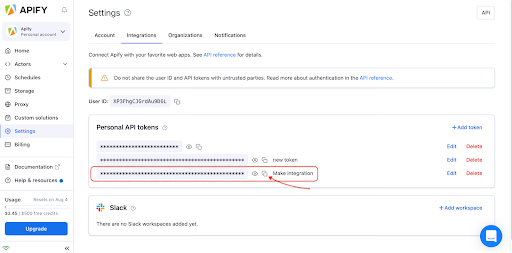| Active with remarks |
|---|
| This application needs additional settings. Please follow the documentation below to create your own connectionUnique, active service acces point to a network. There are different types of connections (API key, Oauth…). More. |
The Apify modulesThe module is an application or tool within the Boost.space system. The entire system is built on this concept of modularity. (module - Contacts) More allow you to monitor and run actors and tasks or fetch dataset itemsItems are rows in records (order/request/invoice/purchase...) in your Apify account.
To get started with APify, create an at my.apify.com.
Connect Apify to Boost.spaceCentralization and synchronization platform, where you can organize and manage your data. More IntegratorPart of the Boost.space system, where you can create your connections and automate your processes. More
To connect your Apify account to Boost.space Integrator you need to obtain the API TokenThe API token is a multi-digit code that allows a user to authenticate with cloud applications. More from your Apify account.
-
Log in to your Apify account.
-
Click Settings > Integrations.
-
Click + Add tokenThe API token is a multi-digit code that allows a user to authenticate with cloud applications. More.
-
In the Add authentication token popup, enter a name for your token, and click Save.
-
Copy the token by clicking the Copy button.
-
Go to Boost.space Integrator and open the Create a connection dialog of the desired Apify moduleThe module is an application or tool within the Boost.space system. The entire system is built on this concept of modularity. (module - Contacts) More.
-
In the API token field, enter the value copied in step 5 and click Save.
TriggersEvery scenario has a trigger, an event that starts your scenario. A scenario must have a trigger. There can only be one trigger for each scenario. When you create a new scenario, the first module you choose is your trigger for that scenario. Create a trigger by clicking on the empty module of a newly created scenario or moving the... when a selected actor run is finished.
|
WebhookA webhook is a way for an app to send real-time information to a specific URL in response to certain events or triggers. name |
Enter the desired name for the webhook. E.g. Finished Web Scraper Run. |
|
Connection |
|
|
Actor |
Select the Actor you want to monitor for finished runs. |
Triggers when a selected task run is finished.
|
Webhook name |
Enter the desired name for the webhook. E.g. Finished Web Scraper Run. |
|
Connection |
|
|
Actor |
Select the Actor you want to monitor for finished runs. |
Runs a selected actor task.
|
Connection |
|
|
Task |
Select or map the task you want to run. |
|
Run synchronously |
Boost.space Integrator will wait until the task run is finished. Beware that the maximum timeout for the run is 120 seconds. |
|
Input JSON overrides |
Here you can enter a JSON object to override the task input configuration. Only the provided fields will be overridden, the rest will be left unchanged. You can see the JSON task input configuration when you switch from Editor to Raw display of the input configuration. 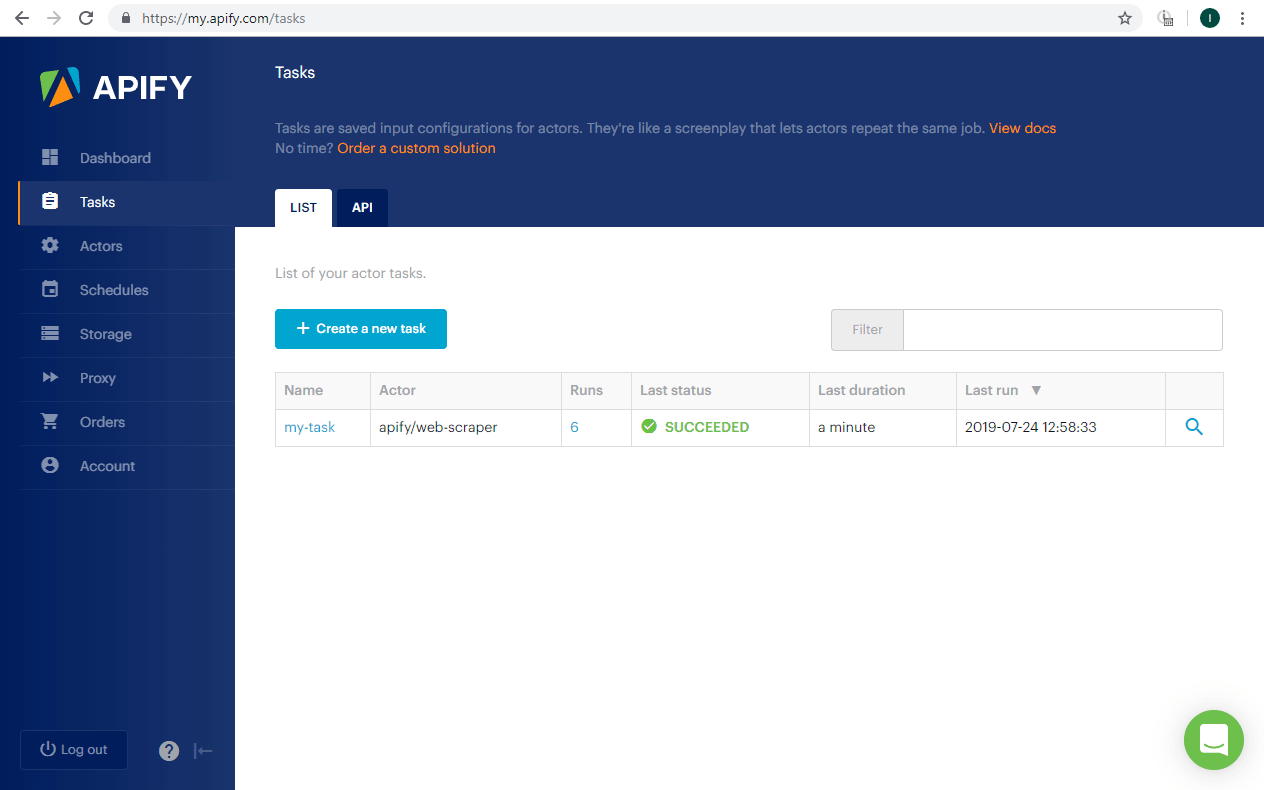 |
Runs a selected actor.
|
Connection |
|
|
Actor |
Select or map the ID of the actor you want to run. |
|
Run synchronously |
Boost.space Integrator will wait until the task run is finished. Beware that the maximum timeout for the run is 120 seconds. |
|
Input JSON |
Here you can enter a JSON object to override the actor default configuration. Only the provided fields will be overridden, the rest will be left unchanged. You can see the JSON actor input configuration when you switch from Editor to Raw display of the input configuration. 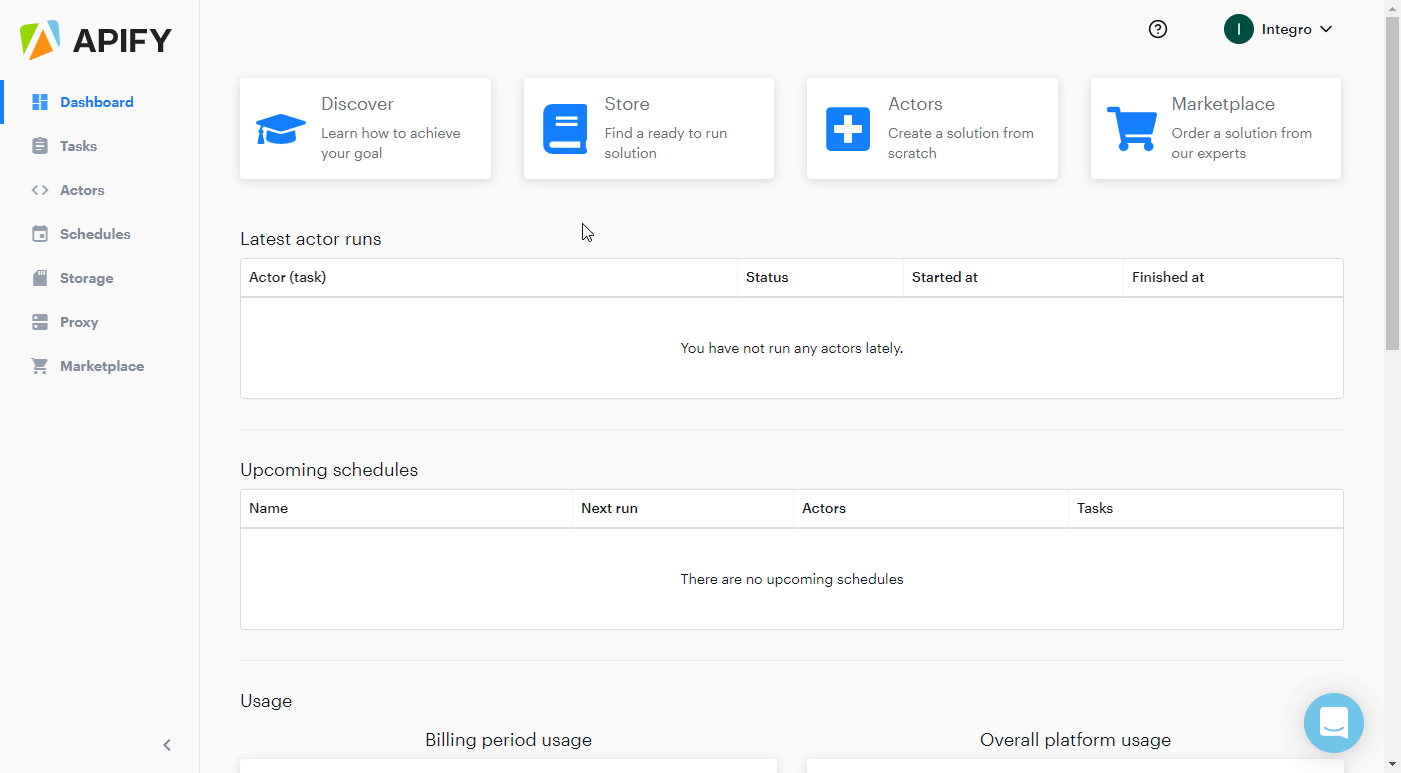 |
|
Build |
Specify the actor build to run. It can be either a build tag or build number. By default, the run uses the build specified in the default run configuration for the actor (typically ‘latest’). |
|
Timeout |
Enter the timeout for the run in seconds. By default, the run uses a timeout specified in the default run configuration for the actor. |
|
Memory |
Select or enter memory limit for the run, in megabytes. By default, the run uses a memory limit specified in the default run configuration for the actor. |
Retrieves items from a dataset.
|
Connection |
|
|
Dataset ID |
Enter the ID of the dataset you want to retrieve items from. |
|
Data transformation |
Select a type of data transformation.
|
|
Format |
Select the format of the dataset items. |
|
Limit |
Set the maximum number of items Boost.space Integrator will return during one execution cycleA cycle is the operation and commit/rollback phases of scenario execution. A scenario may have one or more cycles (one is the default).. |
|
Offset |
Enter the number of items to skip. |
For more detailed information about the rest of the module functionsFunctions you can use in Boost.space Integrator - create, update, delete, get, search., please refer to the APIFY Docs.

